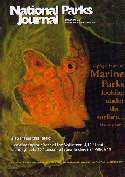
Back to Contents

Back to Contents
|
Cover Story |
Testing the waters
Andrew Cox
NPA Executive Officer
 Back to Contents |
Testing the waters Andrew Cox
|
| It would be easy to believe that the protection of the NSW marine environment has greatly improved over the last decade. However, when looking closely at government initiatives during this time, ANDREW COX decides that little has changed. |
| When NPA began its campaign
for new marine national park legislation in 1995 less than 0.05% of NSW
waters were fully protected in ‘sanctuary areas’ — the marine
equivalent of protection offered by terrestrial national parks or nature
reserves. Today, the figure still stands below the paltry 0.05% figure.
Yet in this time the State Government has created the perception of action by:
It is also about to release a draft aquatic biodiversity strategy. |
|
Australian marine parks are created under the ‘multiple use’ model. This model means that a range of exploitative uses can occur in the one area.
In practice, instead of conservation being the overriding objective, multiple use aims to manage conflict between potentially conflicting uses. Multiple use legitimates ecologically unsustainable use under the guise of conservation.
The iconic Great Barrier Reef Marine Park is the best known example of this approach. More than 90% of this park is a general multiple use zone, and thus the park fails to properly protect the internationally significant reef. Conservation groups such as WWF have called for at least 50% of the park to be fully protected.
Multiple-use management zones need to be built around fully protected areas, not within them. Marine parks first and foremost should be managed for the marine environment using an ecosystem approach (VNPA 2001). The NSW Government has also adopted the same multiple use model where the majority of the marine parks are zoned for general use.
Government documents and policies talk about establishing a ‘protected area system’. But what really is their definition of a protected area?
On the land, governments regard protected areas as land permanently protected for conservation where all all animals, plants and other living things cannot be harmed or killed.
For marine areas, the multiple use marine parks qualify as a protected area, and commercial and recreational fishing and shipping continue in most areas with few additional constraints.
Under the NSW Marine Parks Act, the Marine Parks Authority that manages the marine parks is headed by a tripartite consisting of the Minister for Fisheries, the Minister for the Environment and the head of the Premier's Department. While the objectives of a marine park are good, it’s the resource exploitation model that dominates. The power of the Minister for the Environment is limited, and this shows in the direction of the Authority, its publications and the management of marine parks — conservation comes a poor second.
Aquatic reserves, also a potential component of the marine protected area system, are managed by NSW Fisheries and usually don’t fully protect all things within the area.
The NPA advocates that:
4. national parks and nature reserves adjacent to marine areas should be extended to absolute low water to ensure full protection regardless of whether tide is in or out – most parks and reserves only extend to high water. |
|
|
National
Parks Association - Home Page |
|